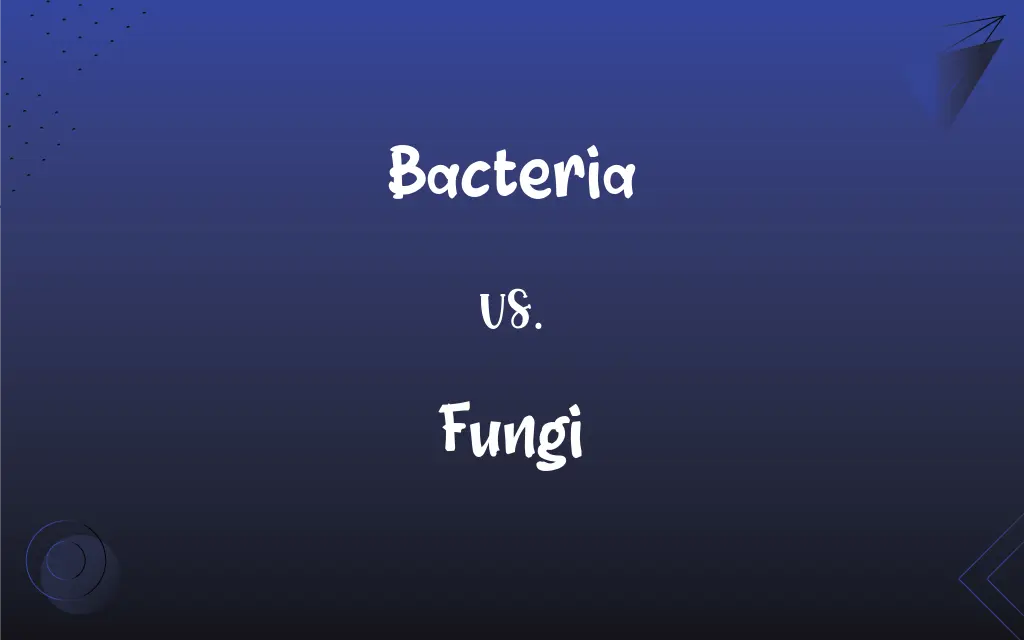Bacteria vs. Fungi: What's the Difference?
Edited by Janet White || By Harlon Moss || Updated on August 6, 2024
Bacteria are single-celled prokaryotic microorganisms; fungi are eukaryotic organisms that include yeasts, molds, and mushrooms.

Key Differences
Bacteria are microscopic entities that belong to the prokaryotic class of life forms. This means that their cells do not contain a nucleus. They are incredibly diverse and can be found in a multitude of environments, from the human body to the deepest parts of the ocean. Fungi, on the other hand, belong to the eukaryotic class, meaning their cells contain a nucleus.
While both bacteria and fungi play critical roles in the ecosystem, their structures and functionalities differ considerably. Bacteria can be rod-shaped, spherical, or spiral, and often multiply by binary fission. Fungi consist of a complex network of filaments called hyphae and reproduce through both sexual and asexual means, often by producing spores.
From a medical perspective, bacteria and fungi can both be pathogens, causing diseases in humans and other animals. However, antibiotics typically treat bacterial infections, while antifungal medications address fungal infections. Additionally, while some bacteria can be beneficial, aiding in digestion or producing vitamins, certain fungi can be useful in food production, like yeast in bread or penicillium in cheese.
Nutritionally, bacteria typically obtain their energy from organic or inorganic sources, and some can even produce energy through photosynthesis. Fungi, conversely, are heterotrophic, meaning they obtain their energy by absorbing nutrients from other organisms, often decomposing dead organic material in the process.
In terms of size, bacteria are generally smaller than fungi. While a bacterial cell might range from 0.5 to 5 micrometers in size, fungi can be seen with the naked eye, especially when they form large structures like mushrooms or molds. Nonetheless, despite these differences, both bacteria and fungi remain integral to the balance and health of our planet's ecosystems.
ADVERTISEMENT
Comparison Chart
Cell Type
Prokaryotic (no nucleus)
Eukaryotic (has a nucleus)
Size
Typically smaller (0.5 to 5 micrometers)
Larger, some forms visible to the naked eye
Reproduction
Mostly by binary fission
Through budding in yeasts
Nutrition
Can be autotrophic or heterotrophic
Heterotrophic, often decomposers
Typical Medications for Infections
Antibiotics
Antifungals
ADVERTISEMENT
Bacteria and Fungi Definitions
Bacteria
Single-celled prokaryotic microorganisms.
Bacteria in the gut help digest food.
Fungi
Decomposers that absorb nutrients from organic material.
Fungi play a role in breaking down fallen leaves in a forest.
Bacteria
Microbes that lack a nucleus in their cells.
Bacteria can cause diseases like tuberculosis.
Fungi
Eukaryotic organisms that include yeasts, molds, and mushrooms.
Fungi like mushrooms can be found growing in the forest.
Bacteria
Tiny organisms found in diverse environments.
Bacteria are used in making yogurt through fermentation.
Fungi
Organisms with a complex network of filaments called hyphae.
The visible part of mold on bread is a collection of fungal hyphae.
Bacteria
Entities that can reproduce rapidly through binary fission.
Under favorable conditions, bacteria can double their population in just 20 minutes.
Fungi
Entities that reproduce through spores.
Fungi can spread in an environment by releasing airborne spores.
Bacteria
Organisms that can be beneficial or pathogenic.
While some bacteria aid in digestion, others can cause infections.
Fungi
Heterotrophic organisms often used in food and medicine production.
Fungi are essential for making products like beer, bread, and some antibiotics.
Bacteria
Plural of bacterium.
Fungi
A plural of fungus.
FAQs
Can both bacteria and fungi cause diseases?
Yes, both can be pathogens, but they cause different types of infections.
How do bacteria reproduce?
Bacteria primarily reproduce by binary fission.
Are all fungi decomposers?
While many fungi are decomposers, not all fungi serve this role.
How can I distinguish bacteria from fungi under a microscope?
Bacteria are generally smaller and lack a nucleus, while fungi have a more complex structure with a nucleus.
Are bacteria visible to the naked eye?
Individual bacteria are microscopic, but colonies can sometimes be visible.
What are fungi?
Fungi are eukaryotic organisms, including yeasts, molds, and mushrooms.
What's the significance of bacteria in the food industry?
Bacteria are used in fermentation processes, like making yogurt or pickles.
Why are fungi important in medicine?
Fungi are sources for antibiotics like penicillin and other medicines.
Are all bacteria and fungi harmful to humans?
No, only a fraction of bacteria and fungi are pathogenic to humans; many are harmless or even beneficial.
Can bacteria undergo photosynthesis?
Some bacteria, like cyanobacteria, can perform photosynthesis.
Do fungi produce food through photosynthesis?
No, fungi do not perform photosynthesis; they are heterotrophic.
Can fungi be multicellular?
Yes, many fungi, like mushrooms, are multicellular.
Where can I find bacteria in my home?
Bacteria are everywhere, including on surfaces, in the air, and on the human body.
Are fungi always harmful to plants?
While some fungi are plant pathogens, others form beneficial relationships with plants.
How do bacteria benefit the environment?
Bacteria help decompose waste, fix nitrogen, and play roles in various nutrient cycles.
What role do fungi play in ecosystems?
Fungi decompose organic material, recycle nutrients, and form symbiotic relationships with plants.
How do fungi obtain their nutrients?
Fungi are heterotrophic and absorb nutrients from organic material.
What are bacteria?
Bacteria are single-celled prokaryotic microorganisms.
How do antifungals work against fungal infections?
Antifungals target the cellular components unique to fungi, inhibiting their growth.
Are there beneficial bacteria?
Yes, many bacteria, like those in our gut, are beneficial and essential for our health.
About Author
Written by
Harlon MossHarlon is a seasoned quality moderator and accomplished content writer for Difference Wiki. An alumnus of the prestigious University of California, he earned his degree in Computer Science. Leveraging his academic background, Harlon brings a meticulous and informed perspective to his work, ensuring content accuracy and excellence.
Edited by
Janet WhiteJanet White has been an esteemed writer and blogger for Difference Wiki. Holding a Master's degree in Science and Medical Journalism from the prestigious Boston University, she has consistently demonstrated her expertise and passion for her field. When she's not immersed in her work, Janet relishes her time exercising, delving into a good book, and cherishing moments with friends and family.
































































